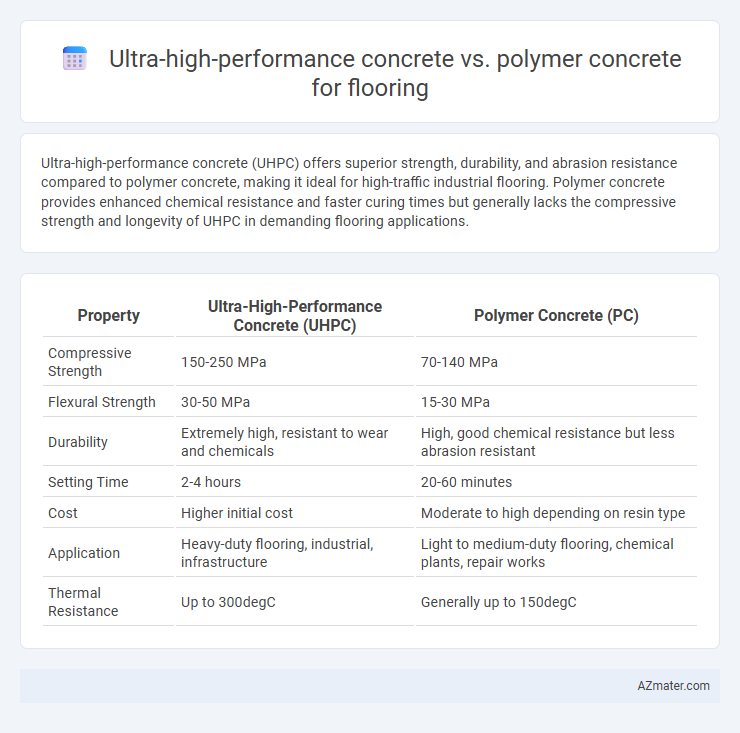Ultra-high-performance concrete (UHPC) offers superior strength, durability, and abrasion resistance compared to polymer concrete, making it ideal for high-traffic industrial flooring. Polymer concrete provides enhanced chemical resistance and faster curing times but generally lacks the compressive strength and longevity of UHPC in demanding flooring applications.
Table of Comparison
| Property | Ultra-High-Performance Concrete (UHPC) | Polymer Concrete (PC) |
|---|---|---|
| Compressive Strength | 150-250 MPa | 70-140 MPa |
| Flexural Strength | 30-50 MPa | 15-30 MPa |
| Durability | Extremely high, resistant to wear and chemicals | High, good chemical resistance but less abrasion resistant |
| Setting Time | 2-4 hours | 20-60 minutes |
| Cost | Higher initial cost | Moderate to high depending on resin type |
| Application | Heavy-duty flooring, industrial, infrastructure | Light to medium-duty flooring, chemical plants, repair works |
| Thermal Resistance | Up to 300degC | Generally up to 150degC |
Introduction to Advanced Flooring Materials
Ultra-high-performance concrete (UHPC) offers exceptional strength, durability, and resistance to abrasion, making it ideal for industrial and commercial flooring applications requiring long-lasting performance. Polymer concrete integrates polymer resins to enhance chemical resistance, flexibility, and rapid curing times, suitable for environments exposed to harsh chemicals and mechanical stress. Both materials represent advanced solutions for high-performance flooring, with UHPC emphasizing structural robustness and polymer concrete prioritizing adaptability and chemical resilience.
Defining Ultra-High-Performance Concrete (UHPC)
Ultra-High-Performance Concrete (UHPC) is a cementitious material characterized by exceptional strength, durability, and density, often exceeding compressive strengths of 150 MPa. It incorporates fine powders, fibers, and optimized particle packing to achieve superior mechanical properties and longevity, making it ideal for demanding flooring applications. Compared to Polymer Concrete, which relies on resin binders for chemical resistance and flexibility, UHPC offers enhanced structural performance and resistance to wear and impact.
Understanding Polymer Concrete
Polymer concrete significantly enhances flooring durability by combining resin binders with aggregates, resulting in superior chemical resistance and reduced permeability compared to conventional concrete. Unlike ultra-high-performance concrete (UHPC), which relies on fine powders and steel fibers for strength, polymer concrete excels in rapid curing times and exceptional adhesion to substrates, making it ideal for industrial and commercial flooring. Its lightweight composition and resistance to abrasion and corrosion further extend flooring lifespan in demanding environments.
Key Material Properties Comparison
Ultra-high-performance concrete (UHPC) exhibits exceptional compressive strength exceeding 150 MPa, superior durability, and excellent abrasion resistance, making it ideal for high-load flooring applications. Polymer concrete, composed of resin binders and aggregates, offers high chemical resistance, rapid curing times, and enhanced flexibility, but generally has lower compressive strength between 40-90 MPa. Key material property differences include UHPC's superior mechanical strength and longevity versus polymer concrete's improved chemical resistance and adaptability for specialized flooring environments.
Strength and Durability Differences
Ultra-high-performance concrete (UHPC) exhibits compressive strengths exceeding 150 MPa, significantly outperforming polymer concrete, which typically ranges between 20-70 MPa, making UHPC more suitable for heavy-duty flooring applications requiring exceptional load-bearing capacity. UHPC's dense microstructure enhances durability by resisting abrasion, chemical attacks, and freeze-thaw cycles, whereas polymer concrete offers moderate chemical resistance but lower mechanical toughness under dynamic stresses. The superior tensile and flexural strength of UHPC also reduces cracking and extends service life compared to polymer concrete, which is more prone to brittle failure in high-stress flooring environments.
Resistance to Chemicals and Abrasion
Ultra-high-performance concrete (UHPC) exhibits exceptional resistance to chemicals such as acids, alkalis, and solvents, making it ideal for industrial flooring exposed to harsh environments. Polymer concrete enhances abrasion resistance due to its thermosetting resin matrix, offering superior durability under heavy mechanical wear. UHPC typically provides a denser microstructure, resulting in reduced permeability and higher chemical resistance, while polymer concrete excels in flexibility and impact resistance for flooring applications.
Installation Methods and Curing Times
Ultra-high-performance concrete (UHPC) requires meticulous installation methods involving precision formwork and vibration techniques to achieve its dense matrix, typically followed by curing processes lasting 7 to 14 days to reach optimal strength. Polymer concrete offers faster installation with simpler placement procedures and often utilizes ambient curing or accelerated methods, allowing it to cure within 24 to 48 hours. The extended curing time of UHPC supports its superior durability and compressive strength, whereas polymer concrete prioritizes rapid turnaround times suitable for quick repairs and overlays.
Cost Analysis: UHPC vs Polymer Concrete
Ultra-high-performance concrete (UHPC) typically incurs higher initial costs ranging from $300 to $400 per cubic yard due to advanced material components and specialized labor, whereas polymer concrete averages between $150 and $250 per cubic yard, offering a more budget-friendly option. Despite the higher upfront investment, UHPC provides superior durability, longer lifespan, and lower maintenance costs, which can translate into greater long-term savings for flooring applications. Polymer concrete presents a cost-effective alternative with faster curing times and sufficient chemical resistance, but may require more frequent repairs, influencing total cost of ownership.
Sustainability and Environmental Impacts
Ultra-high-performance concrete (UHPC) offers exceptional durability and strength, reducing the need for frequent repairs and replacements, which minimizes lifecycle environmental impact in flooring applications. Polymer concrete integrates recycled polymers and resins, promoting waste valorization and lower carbon footprint through reduced cement usage. Both materials enhance sustainability by extending service life and optimizing resource efficiency, though UHPC typically has higher embodied energy compared to polymer concrete variants.
Application Suitability: Which Concrete for Your Flooring?
Ultra-high-performance concrete (UHPC) offers exceptional strength, durability, and resistance to wear, making it ideal for industrial and heavy-traffic flooring applications where load-bearing capacity and longevity are critical. Polymer concrete provides superior chemical resistance, quick curing times, and excellent adhesion to substrates, making it suitable for environments exposed to harsh chemicals or requiring rapid installation. Choosing between UHPC and polymer concrete depends on specific flooring needs such as load intensity, chemical exposure, and installation time constraints.

Infographic: Ultra-high-performance concrete vs Polymer concrete for Flooring
 azmater.com
azmater.com